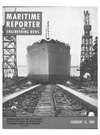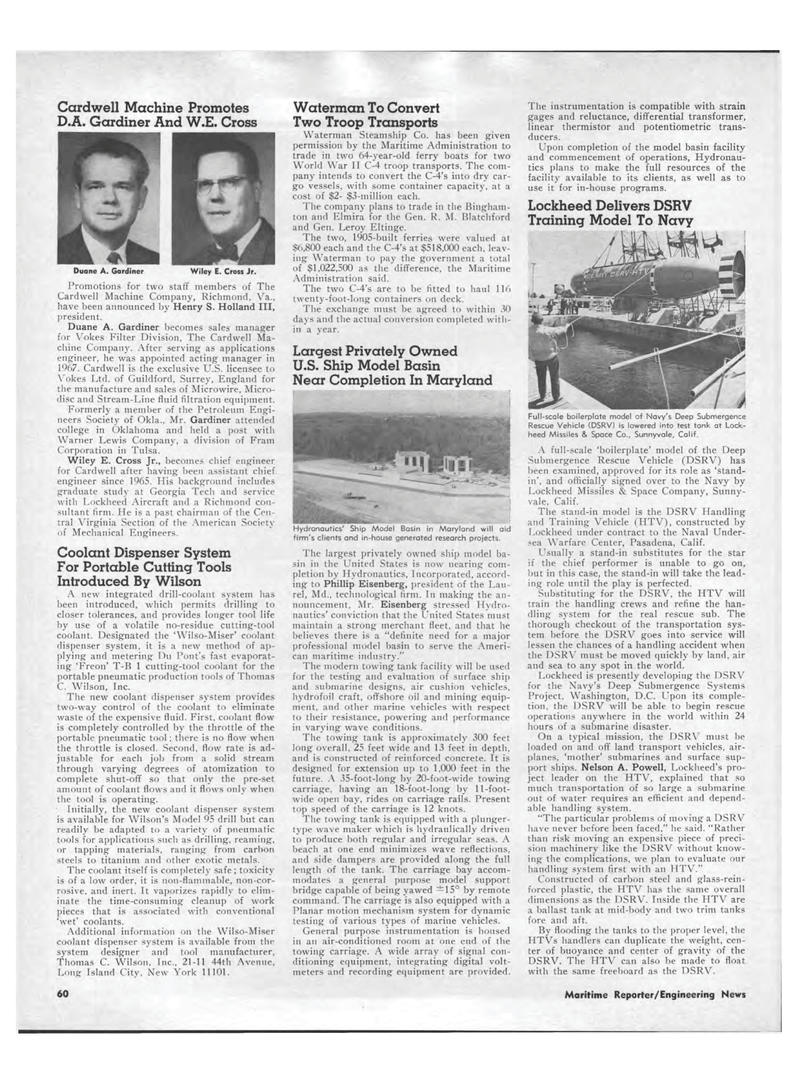
Page 54: of Maritime Reporter Magazine (February 15, 1969)
Read this page in Pdf, Flash or Html5 edition of February 15, 1969 Maritime Reporter Magazine
Cardwell Machine Promotes D.A. Gardiner And W.E. Cross Wiley E. Cross Jr. Promotions for two staff members of The Cardwell Machine Company, Richmond, Va., have been announced by Henry S. Holland III, president. Duane A. Gardiner becomes sales manager for Vokes Filter Division, The Cardwell Ma-chine Company. After serving as applications engineer, he was appointed acting manager in 1967. Cardwell is the exclusive U.S. licensee to Yokes Ltd. of Guildford. Surrey, England for the manufacture and sales of Microwire, Micro-disc and Stream-Line fluid filtration equipment. Formerly a member of the Petroleum Engi-neers Society of Okla.. Mr. Gardiner attended college in Oklahoma and held a post with Warner Lewis Company, a division of Fram Corporation in Tulsa. Wiley E. Cross Jr., becomes chief engineer for Cardwell after having been assistant chief engineer since 1965. His background includes graduate study at Georgia Tech and service with Lockheed Aircraft and a Richmond con-sultant firm. He is a past chairman of the Cen-tral Virginia Section of the American Society of Mechanical Engineers. Coolant Dispenser System For Portable Cutting Tools Introduced By Wilson A new integrated drill-coolant system has been introduced, which permits drilling to closer tolerances, and provides longer tool life by use of a volatile no-residue cutting-tool coolant. Designated the 'Wilso-Miser' coolant dispenser system, it is a new method of ap-plying and metering Du Pont's fast evaporat-ing 'Freon' T-B 1 cutting-tool coolant for the portable pneumatic production tools of Thomas C. Wilson, Inc. The new coolant dispenser system provides two-way control of the coolant to eliminate waste of the expensive fluid. First, coolant flow is completely controlled by the throttle of the portable pneumatic tool; there is no flow when the throttle is closed. Second, flow rate is ad-justable for each job from a solid stream through varying degrees of atomization to complete shut-off so that only the pre-set amount of coolant flows and it flows only when the tool is operating. Initially, the new coolant dispenser system is available for Wilson's Model 95 drill but can readily be adapted to a variety of pneumatic tools for applications such as drilling, reaming, or tapping materials, ranging from carbon steels to titanium and other exotic metals. The coolant itself is completely safe ; toxicity is of a low order, it is non-flammable, non-cor-rosive, and inert. It vaporizes rapidly to elim-inate the time-consuming cleanup of work pieces that is associated with conventional 'wet' coolants. Additional information on the Wilso-Miser coolant dispenser system is available from the system designer and tool manufacturer, Thomas C. Wilson, Inc., 21-11 44th Avenue, Long Island City. New York 11101. Waterman To Convert Two Troop Transports Waterman Steamship Co. has been given permission by the Maritime Administration to trade in two 64-year-old ferry boats for two World War II C-4 troop transports. The com-pany intends to convert the C-4's into dry car-go vessels, with some container capacity, at a cost of $2- $3-million each. The company plans to trade in the Bingham-ton and Elmira for the Gen. R. M. Blatchford and Gen. Leroy Eltinge. The two, 1905-built ferries were valued at $6,800 each and the C-4's at $518,000 each, leav-ing Waterman to pay the government a total of $1,022,500 as the difference, the Maritime Administration said. The two C-4's are to be fitted to haul 116 twenty-foot-long containers on deck. The exchange must be agreed to within 30 days and the actual conversion completed with-in a year. Largest Privately Owned U.S. Ship Model Basin Near Completion In Maryland Hydronautics' Ship Model Basin in Maryland will aid firm's clients and in-house generated research projects. The largest privately owned ship model ba-sin in the United States is now nearing com-pletion by Hydronautics, Incorporated, accord-ing to Phillip Eisenberg, president of the Lau-rel, Md., technological firm. In making the an-nouncement, Mr. Eisenberg stressed Hydro-nautics' conviction that the United States must maintain a strong merchant fleet, and that he believes there is a "definite need for a major professional model basin to serve the Ameri-can maritime industry." The modern towing tank facility will be used for the testing and evaluation of surface ship and submarine designs, air cushion vehicles, hydrofoil craft, offshore oil and mining equip-ment, and other marine vehicles with respect to their resistance, powering and performance in varying wave conditions. The towing tank is approximately 300 feet long overall. 25 feet wide and 13 feet in depth, and is constructed of reinforced concrete. It is designed for extension up to 1.000 feet in the future. A 35-foot-long by 20-foot-wide towing carriage, having an 18-foot-long by 11-foot-wide open bay, rides on carriage rails. Present top speed of the carriage is 12 knots. The towing tank is equipped with a plunger-type wave maker which is hydraulically driven to produce both regular and irregular seas. A beach at one end minimizes wave reflections, and side dampers are provided along the full length of the tank. The carriage bay accom-modates a general purpose model support bridge capable of being yawed ?15° by remote command. The carriage is also equipped with a Planar motion mechanism system for dynamic testing of various types of marine vehicles. General purpose instrumentation is housed in an air-conditioned room at one end of the towing carriage. A wide array of signal con-ditioning equipment, integrating digital volt-meters and recording equipment are provided. The instrumentation is compatible with strain gages and reluctance, differential transformer, linear thermistor and potentiometric trans-ducers. Upon completion of the model basin facility and commencement of operations, Hydronau-tics plans to make the full resources of the facility available to its clients, as well as to use it for in-house programs. Lockheed Delivers DSRV Training Model To Navy Full-scale boilerplate model of Navy's Deep Submergence Rescue Vehicle (DSRV) is lowered into test tank at Lock-heed Missiles & Space Co., Sunnyvale, Calif. A full-scale 'boilerplate' model of the Deep Submergence Rescue Vehicle (DSRV) has been examined, approved for its role as 'stand-in', and officially signed over to the Navy by Lockheed Missiles & Space Company, Sunny-vale, Calif. The stand-in model is the DSRV Handling and Training Vehicle (HTV), constructed by Lockheed under contract to the Naval Under-sea Warfare Center, Pasadena, Calif. Usually a stand-in substitutes for the star if the chief performer is unable to go on, but in this case, the stand-in will take the lead-ing role until the play is perfected. Substituting for the DSRV, the HTV will train the handling crews and refine the han-dling system for the real rescue sub. The thorough checkout of the transportation sys-tem before the DSRV goes into service will lessen the chances of a handling accident when the DSRV must be moved quickly by land, air and sea to any spot in the world. Lockheed is presently developing the DSRV for the Navy's Deep Submergence Systems Project. Washington, D.C. L'pon its comple-tion, the DSRV will be able to begin rescue operations anywhere in the world within 24 hours of a submarine disaster. On a typical mission, the DSRV must be loaded on and off land transport vehicles, air-planes, 'mother' submarines and surface sup-port ships. Nelson A. Powell, Lockheed's pro-ject leader on the HTV, explained that so much transportation of so large a submarine out of water requires an efficient and depend-able handling system. "The particular problems of moving a DSRV have never before been faced," he said. "Rather than risk moving an expensive piece of preci-sion machinery like the DSRV without know-ing the complications, we plan to evaluate our handling system first with an HTV." Constructed of carbon steel and glass-rein-forced plastic, the HTV has the same overall dimensions as the DSRV. Inside the HTV are a ballast tank at mid-body and two trim tanks fore and aft. By flooding the tanks to the proper level, the HTVs handlers can duplicate the weight, cen-ter of buoyance and center of gravity of the DSRV. The HTV can also be made to float with the same freeboard as the DSRV. Duane A. Gardiner 60 Maritime Reporter/Engineering News

 53
53

 55
55
